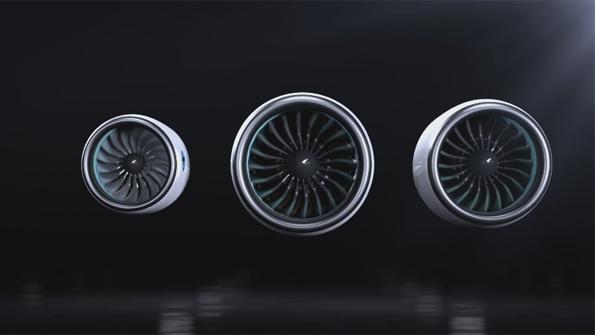Pratt & Whitney GTF Engines are Creating New Routes and Powering the Future

Pratt & Whitney continues to see broad excitement and strong orders for its revolutionary Pratt & Whitney GTF family of geared turbofan engines. Recent wins add to the Pratt & Whitney GTF order book, which now totals nearly 10,000 engine orders and commitments with more than 80 customers. Several of these airlines have also signed multi-year contracts for Pratt & Whitney’s EngineWise® comprehensive service agreements, dedicated to sharing the company’s engine expertise and fleet intelligence with customers so they can optimize engine performance and keep their operations running smoothly.
The most recent deliveries continue to add to the ever-growing commercial fleet, which now totals more than 460 Pratt & Whitney GTF-powered aircraft across 37 operators since the engine entered service in 2016. This April, the Embraer E190-E2 launch customer, Widerøe Airlines in Norway, celebrated its one year anniversary of passenger service. The larger Embraer E195-E2 is slated to enter service later this year with Azul Brazilian Airlines. The Mitsubishi MRJ and Irkut MC-21 also will enter service over the next couple of years.
Orders of Pratt & Whitney GTF engines during the last 12 months include Air Peace’s firm order of 10 E195-E2 aircraft, exclusively powered by Pratt & Whitney GTF engines; JetBlue’s selection of 60 firm A220 aircraft, exclusively powered by Pratt & Whitney GTF engines; Delta Air Lines’ addition of 15 A220 aircraft increasing its total firm order to 90 A220 aircraft; a U.S.-based startup airline’s order of 60 A220 aircraft; Air Transat’s choice of the Pratt & Whitney GTF engine for their order of 17 A321neo family aircraft; airBaltic’s order of 30 A220 aircraft with option for an additional 30 aircraft; and Aegean Airlines selection of the Pratt & Whitney GTF engine to power up to 62 A320neo family aircraft.
Aircraft deliveries over the past year have ranged from Delta Air Lines taking delivery of their first A220 aircraft and becoming the first U.S.-based A220 operator, to China-based Qingdao Airlines accepting delivery of their first A320neo, to Air Tanzania taking delivery of their first A220 late last year and becoming the first Pratt & Whitney GTF operator based in Africa.
Airline customers recently placing these orders and accepting deliveries believe in the Pratt & Whitney GTF engine. "This selection marks a milestone for our airline," said Robin Hayes, chief executive officer, JetBlue. "The role Pratt & Whitney has played in the development of this aircraft – and, in fact, all the great aircraft we've considered – is a testament to the company's vision and its talented team. We look forward to the benefits the GTF will bring to our airline and to our customers."
Current in-service engine performance has more than lived up to the early promise of the Pratt & Whitney GTF. Since entering the market, Pratt & Whitney GTF engines have compiled more than 2.5 million engine revenue hours and demonstrated an ability to reduce fuel burn by 16 to 20 percent, saving customers a staggering 146 million gallons of fuel, totaling more than $250 million in savings to date.
The Pratt & Whitney GTF engine also significantly reduces regulated emissions, which has led to 1.4 million metric tonnes of carbon emissions avoided so far, and lowers the noise footprint by 75 percent. Engines in service are saving approximately 100 gallons of fuel and reducing CO2 emissions by one metric ton per flight hour.
The performance of the Pratt & Whitney GTF could have a significant impact on how and where airlines fly. For example, the engine’s impressive reduction in the overall noise footprint could increase air travel at airports where noise regulations have limited the ability to fly at certain times of the day. And reduced fuel burn will allow operators the ability to extend routes by using the same amount of fuel, creating options for routes that didn’t exist before and making point-to-point destinations more available to the flying public.
Industry-disrupting technologies set the Pratt & Whitney GTF apart from its competition. The engine’s revolutionary architecture allows for further evolution and performance enhancements, and it is creating new opportunities for how and where airlines fly.
The company invested more than 20 years in the engine, maturing new technologies that enable its impressive results. To meet the production demands of a historic engine ramp, Pratt & Whitney has invested in its 21st century global production facilities to deliver its products quicker and with the highest quality. Along with its MRO network partners, the company is investing millions to increase maintenance capability to support the in-service fleet.
Clearly, the investment in infrastructure is paying off. Through its demonstrated performance in the field, the Pratt & Whitney GTF is proving to be everything it promised to be. “We are proud to welcome our first GTF-powered A321neo aircraft to our growing fleet,” said Wizz Air CEO József Váradi.
“We are convinced that the A321neo will be a game-changing aircraft for Wizz Air as we continue to grow and expand our market reach across and beyond Europe. This next-step technology aircraft will enable us to become a greener airline while lowering our operating costs.”




